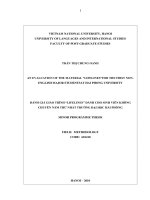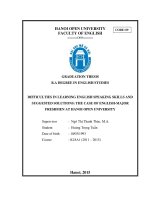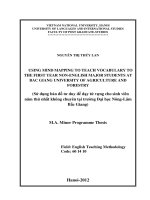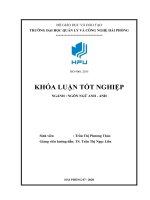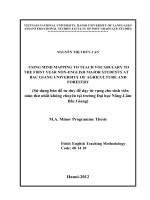Common errors in the use of english articles by vietnamese third year english major students at an giang university submitted in partial fulfillment of the requirements for the degree
Bạn đang xem bản rút gọn của tài liệu. Xem và tải ngay bản đầy đủ của tài liệu tại đây (568.1 KB, 100 trang )
VIETNAM NATIONAL UNIVERSITY - HO CHI MINH CITY
UNIVERSITY OF SOCIAL SCIENCES AND HUMANITIES
PHAN THỊ MINH TUYỀN
COMMON ERRORS IN THE USE OF ENGLISH ARTICLES
BY VIETNAMESE THIRD-YEAR ENGLISH-MAJOR STUDENTS
AT AN GIANG UNIVERSITY
M.A. THESIS
SUBMITTED IN PARTIAL FULFILLMENT
OF THE REQUIREMENTS FOR THE DEGREE OF
MASTER OF ARTS IN TESOL
Supervisor
Assoc. Prof., PhD. ĐINH ĐIỀN
HO CHI MINH CITY, 2010
CERTIFICATE OF ORIGINALITY
I certify my authorship of the thesis submitted today entitled:
COMMON ERRORS IN THE USE OF ENGLISH ARTICLES
BY VIETNAMESE THIRD-YEAR ENGLISH-MAJOR STUDENTS
AT AN GIANG UNIVERSITY
in terms of the statement of Requirements for theses
in Master’s Programs issued by the Higher Degree Committee.
This thesis has not been submitted for the award of any degree
or diploma in any other institution.
Ho Chi Minh City, 2010
PHAN THỊ MINH TUYỀN
RETENTION AND USE OF THE THESIS
I hereby state that I, PHAN THỊ MINH TUYỀN, being the candidate for the
degree of Master of Arts (TESOL), accept the requirements of the University
relating to the retention and use of Master’s Theses deposited in the Library.
In terms of these conditions, I agree that the original of my thesis deposited in
the Library should be accessible for purposes of study and research, in
accordance with the normal conditions established by the Library for the care,
loan or reproduction of theses.
Ho Chi Minh City, 2010
PHAN THỊ MINH TUYỀN
ACKNOWLEDGEMENTS
I am deeply indebted to a number of people for helping to make this MA thesis
possible. First and foremost, my deepest gratitude goes to my supervisor, Associate
Professor Dr. Dinh Dien for his insightful comments, invaluable suggestions and a
great encouragement during the process I conducted the thesis.
I would also like to express my special thanks to Dr. To Minh Thanh, my
teacher at the University of Social Sciences and Humanities, for her useful suggestions
on my thesis proposal.
Next, my appreciation is also extended to the Vietnamese teachers and students
who participated in my study. Their help is highly appreciated. I would also like to
thank the English Department of An Giang University for providing the most favorable
conditions which made my study possible.
Last but not least, I would like to thank my family and friends for their great
support and willing assistance in completing this work.
ABSTRACT
This study was intended to investigate common errors in the use of English
articles made by the third-year English major students at An Giang University in order
to enhance the effectiveness of EFL teaching and learning in Vietnam in general and
teaching and learning English article system in particular. The participants in the study
consisted of 44 third-year English major students at An Giang University. The data
were collected via writing essays which aimed to identify common article errors,
determine the frequency of the article errors in comparison with other types of errors.
A fill-in-the-blank test was also employed to get more information about the particular
types of article errors made and explain the reasons which the students finally arrived
at their choices of articles. In addition, a pretest-posttest comparison group design was
conducted to confirm the effectiveness of using corpus-based analysis in helping
students overcome their problems of acquiring the English articles. Both quantitative
and qualitative data were analyzed to answer three research questions concerning three
areas: (1) common article errors in the writing essays made by the Vietnamese thirdyear English-major students at AGU, (2) difficulties of acquiring the semantic notions
of the English articles, and (3) the effectiveness of applying corpus-based analysis in
helping students overcome their problems.
The findings showed that the English majors made different types of errors and
among them the English articles were found their most concerning problems. The
students tended to make more errors relating contextual choices such as unique types,
maximal instances, and actual instances, non-definite actual instances, and specificity
with definite and count with non-count nouns. The study also found out the
effectiveness of teaching and learning the English articles with the use of corpus-based
analysis. The results showed that the treatment group did better the control group after
the experiment, especially in using zero and zero in maximal set environments. These
findings suggested that Vietnamese EFL learners, especially learners at high
proficiency level, needed to be equipped with grammatical competence, particularly
the English articles in order to be confident and become professional writers.
LIST OF TABLES
Table 1.1 COBUILD list of the ten most frequent words in English ................ 1
Table 1.2 Percentage of occurrence of the articles in the five genres ............... 2
Table 2.1 Quirk et al.’s classification of nouns .............................................. 11
Table 4.1 Types and descriptions of errors .................................................... 34
Table 4.2 Frequency of different categories of errors in essays ..................... 35
Table 4.3 Environments for the occurrence of the articles ............................. 36
Table 4.6 Group statistics .............................................................................. 42
Table 4.7 Group performance at six NP environments in Post Test 1 ............ 43
Table 4.8 Group performance at six NP environments in Post Test 2 ............ 44
LIST OF FIGURES
Figure 1 Main entries for agree from the Cambridge Advanced Learner’s
Dictionary (CD-ROM 2003) .......................................................... 20
Figure 2 Sample of concordance lines for agree from the PolyU Language
Bank Concordancer ....................................................................... 20
TABLE OF CONTENTS
Certificate of originality ................................................................................... i
Retention and use of the thesis......................................................................... ii
Acknowledgements ........................................................................................ iii
Abstract .......................................................................................................... iv
List of tables ................................................................................................... vi
List of figures ................................................................................................ vii
CHAPTER 1: INTRODUCTION ................................................................. 1
1.1.
Background to the Study ................................................................. 1
1.2.
Statement of Purpose ....................................................................... 4
1.3.
Research Questions ......................................................................... 4
1.4.
Scope of the Study........................................................................... 4
1.5.
Significance of the Study ................................................................. 5
1.6.
Methodology ................................................................................... 5
1.6.1.
The participants of the Study.............................................. 5
1.6.2.
Data collection instruments ................................................ 6
1.6.3.
Procedures of the Study ..................................................... 6
1.7.
Assumptions .................................................................................... 7
1.8.
Overview of the Study ..................................................................... 8
CHAPTER 2: LITERATURE REVIEW ..................................................... 9
2.1.
Articles ............................................................................................ 9
2.1.1.
Definition of articles .......................................................... 9
2.1.2.
2.2.
2.3.
2.4.
Types of articles ............................................................... 10
Classes of Nouns ........................................................................... 11
2.2.1.
Classification of nouns proposed by Quirk at al (1985) .... 11
2.2.2.
Classification of nouns proposed by Langacker (1991) .... 12
2.2.3.
The suggested classification of the article environments .. 13
Acquisition of the English articles by Vietnamese learners ............ 14
2.3.1.
Definite articles ................................................................ 14
2.3.2.
Indefinite articles ............................................................. 15
Corpora and the application of corpus-based analyses in language
teaching and learning..................................................................... 17
2.4.1.
What is a corpus? ............................................................. 17
2.4.1.1. A corpus is a principled collection of texts .......... 18
2.4.1.2. A corpus is a collection of electronic texts ........... 18
2.4.1.3. A corpus is available for qualitative and quantitative
analysis ............................................................... 19
2.4.1.4. Which corpus, what for and what size? ................ 19
2.4.2.
Overview of existing corpora ........................................... 21
2.4.3.
Types of corpora .............................................................. 22
2.4.4.
Corpus use in Vietnam ..................................................... 23
2.4.5.
Applying corpus-based analyses to teaching .................... 24
2.4.5.1. Syllabus design ................................................... 24
2.4.5.2. Materials development........................................ 24
2.4.5.3. Classroom activities ............................................ 24
CHAPTER 3: RESEARCH METHODOLOGY ....................................... 26
3.1.
3.2.
Research questions and hypotheses ............................................... 26
3.1.1.
Research questions ........................................................... 26
3.1.2.
Hypotheses ...................................................................... 26
Research design ........................................................................... 27
3.2.1.
Participants ...................................................................... 27
3.2.2.
Data collection instruments .............................................. 27
3.2.2.1. The writing essay ................................................ 27
3.2.2.2. The fill in the blank test ...................................... 28
3.2.2.3. A pretest-posttest comparison group design ........ 29
3.3.
Summary ....................................................................................... 32
CHAPTER 4: RESULTS AND DISCUSSION .......................................... 33
4.1.
4.2.
Data analysis and results of the writing essay ................................ 33
4.1.1.
Classification of article errors and other type of errors ..... 33
4.1.2.
Data analysis .................................................................... 34
4.1.3.
Discussion ....................................................................... 35
Data analysis and results of the fill in the blank test ....................... 35
4.2.1.
Some explanations relating to zero vs. null and a ............. 35
4.2.2.
Data analysis .................................................................... 38
4.2.3.
Discussion about causes of errors ..................................... 40
4.2.3.1. Names ................................................................. 40
4.2.3.2. Unique types ....................................................... 40
4.2.3.3. Uniquely identified instance ................................ 41
4.2.3.4. Actual instance .................................................... 41
4.2.4.
4.3.
Summary ......................................................................... 41
Data results of the pretest-posttest group design ............................ 42
CHAPTER 5: SUMMARY AND PEDAGOGICAL IMPLICATIONS.... 45
5.1.
Summary of the findings ............................................................... 45
5.2.
Pedagogical implications ............................................................... 46
5.3.
Limitations of the study ................................................................. 48
5.4.
Suggestions for further research .................................................... 49
BIBLIOGRAPHY ....................................................................................... 51
APPENDICES ............................................................................................. 58
Appendix 1A Writing task sample ............................................................... 59
Appendix 1B A graded essay ...................................................................... 60
Appendix 2
Article error analysis test ....................................................... 61
Appendix 3
Pretest 1 on the English articles ............................................. 65
Appendix 4
Pretest 2 on the English articles ............................................. 68
Appendix 5
Post-test 1 on the English articles .......................................... 71
Appendix 6
Post-test 2 on the English articles .......................................... 75
Appendix 7
Taxonomy of the use of English articles based on insights
by Quirk et al and Langacker ................................................. 79
BIBLIOGRAPHY
Agnihotri, R.K., Khanna, A.L., Mukherjee, A. (1984). ‘The use of articles in Indian English:
errors and pedagogical implications.’ IRAL, 22 (2).
Bache, C. & N. Davidsen. (1997). Mastering English Grammar. Berlin: Walter de Grugter &
Co.
Beaumont, M. and C. Gallaway. 1994. ‘Articles of Faith: The Acquisition, Learning and
Teaching of a and the.’ In Bygate, M., A. Tonkyn, and E. Williams (eds.), Grammar and
the Language Teacher. NewYork: Prentice Hall International English Language
Teaching.
Berry, R. 1991. ‘Re-articulating the articles.’ ELT Journal, 45 (1), 252-259. London: British
Council.
Bickerton, D. 1981. Roots of language. Ann Arbor: Karoma.
Bolinger, D. 1975. A postscript to Postal on the article. Modern Language Journal, 59 (4),
181-5.
Brinton, L.J. 2000. The Structure of Modern English: A linguistic introduction. Amsterdam:
John Benjamins Publishing Company.
Brown, G. 1861. The Grammar of English Grammars. New York.
Burt, M.K. 1975. ‘Error Analysis in the Adult EFL Classroom’, TESOL Quarterly, 9 (1).
Burton-Robert, N. (1997). Analysing Sentences – An Introduction to English Syntax. Second
Edition. Addison Wesley Longman Limited.
Burton-Roberts, N. 1976. ‘On the generic indefinite article.’ Language 52 (2), 427-48.
Burton-Roberts, N.1981. ‘Review of J. Hawkins, Definiteness and indefiniteness.’ Language
57 (1), 191-6.
Calder, M., 1972/3. An Analysis of Errors in Article Usage in the Noun Group Area.
Unpublished project in part fulfilment for Dip. T.E.O., University of Manchester.
Cambridge Advanced Learner’s Dictionary Online. Cambridge: Cambridge University Press.
2004.
Cao Xuân Hạo. 1999. Tiếng Việt: Mấy vấn đề về ngữ âm, ngữ pháp, ngữ nghĩa. (The
Vietnamese Language: Some issues on Phonology, Grammar, and Semantics). Hanoi:
Nha xuat ban Giao duc (Education Publishing House)
Carlson, G.N. 2002. ‘A unified Analysis of the English Bare Plural’. In P. Portner & B. H.
Partee (eds), Formal Semantics: The Essential Readings. Oxford: Blackwell Publishers.
Celce-Murcia, M. & D. Larsen-Freeman. 1983. The Grammar Book: An ESL/EFL Teachers’
Course. Boston: Heinle & Heinle Publishers
Chalker, S. 1994. ‘Pedagogical Grammar: Principles and Problems’ in M. Bygate et al. (eds.),
Grammar and the Language Teacher. New York: Prentice Hall International Ltd.
Chesterman, A. 1991. On definiteness: A study with special reference to English and Finnish.
Cambridge, UK: Cambridge University Press.
Christophersen, P. 1939. The Articles: A Study of Their Theory and Use in English.
Copenhagen: Einar Munksgaard.
Diep Quang Ban. (2005). Ngu phap Tieng Viet. (‘A Grammar of the Vietnamese Language’).
Hanoi: Nha xuat ban Giao duc (Education Publishing House).
Dinh Van Duc. (1986). Ngu phap Tieng Viet (‘A Grammar of the Vietnamese Language’).
Hanoi: Nha xuat ban Dai hoc & THCN.
Dinh Van Duc. (2001). Ngu phap Tieng Viet (‘A Grammar of the Vietnamese Language’).
Hanoi: Nha xuat ban Dai hoc quoc gia Ha Noi (Vietnam National University of Ha Noi
Publishing House).
Doff, A. (1988). Teach English – A training course for teachers. Trainer’s Handbook.
Cambridge University Press.
Donnellan, K. 1966. Reference and definite descriptions. Philosophical Review 75, 281-304.
Donnellan, K. 1978. Speaker reference, descriptions, and anaphora. In Syntax and Semantics,
vol. 9: Pragmatics, ed. P. Cole, 47-68. New York: Academic Press.
Downing, A. and Locke, P. (1995). A University Course in English Grammar. Prentice Hall
International.
Durojaiye, S.M., 1962/3. An Analysis of the Errors Made in the English Essays of Fifty
Western Nigerian Grammar School Pupils. Unpublished project in part fulfillment for
Dip. T.E.O., University of Manchester.
E. Williams (eds.), Grammar and the Language Teacher. NewYork: Prentice Hall
International English Language Teaching.
Eastwood, J. (1999). Oxford Practice Grammar. Oxford: Oxford University Press.
Ellis, R. 1994. The Study of second language Acquisition. Oxford: Oxford University Press
Emeneau, M. B. 1951. Studies in Vietnamese Grammar. Berkeley: University of California
Press.
English articles: An Analysis of the Metalinguistic Knowledge Used by Japanese Students in
Acquiring the English Article System.’ SSLA 24, 451-480.
Fauconnier, G. 1985. Mental Spaces: Aspects of Meaning Construction in Natural Language.
Cambridge, Mass: Cambridge UP.
Finegan, E. (1994). Language – its Structure and Use. Harcourt Brace and Company.
Fodor, J.D. and I.A. Sag. 1982. Referential and quantificational indefinites. In Linguistics and
Philosophy 5, 355-98.
Givón, T. 1993. English Grammar: A Function-Based Introduction. Vol.1. Amsterdam: John
Benjamins Publishing Company.
Goto Butler, Yuko. 2002. ‘Second language learners’ theories on the use of grammar. Vol.1.
Berlin: Mouton de Gruyter.
Grannis, O.C. 1972. ‘The definite article conspiracy in English.’ Language Learning, 22 (2),
275-89.
Grice, P. 1981. Presupposition and Conversational Implicature. In P. Cole (ed.) Radical
Pragmatics. New York: Academic Press. Bibliography 281
Guillaume, G. 1975. Le problème de l’article et sa solution dans la langue franỗaise. Quebec:
Presses de lUniversitộ Laval.
Halliday, M.A.K., & R. Hasan. 1976. Cohesion in English. London: Longman.
Hawkins, J.A. 1978. Definiteness and indefiniteness: a study in reference and grammaticality
prediction. London: Croom Helm.
Heidolph (eds.) Progress in linguistics, 233-48. The Hague: Mouton.
Hewings, M. 1999. Advanced Grammar in Use. Cambridge: Cambridge University Press.
Huddleston, R. 2002. The Cambridge Grammar of the English Language. Cambridge:
Cambridge University Press.
Huebner, T. 1983. A longitudinal analysis of the acquisition of English. Ann
Huebner, T. 1985. ‘System and variability in interlanguage syntax. Language Learning. 25,
141-163.
Ihalainen, O.K. 1974. On the modality of English noun phrases, with special reference to
genericity. PhD thesis, University of Wisconsin-Madison.
Jacobs, R.A. (1993). English Syntax – A Grammar for English Language Professionals.
Library of Congress.
Jespersen, O. 1933. Essentials of English Grammar. Boston: George Allen & Unwin.
Jespersen, O. 1949. A modern English grammar on historical principles, part VII: Syntax.
London: Allen and Unwin.
Kaluza, H. 1963. ‘Teaching the English article to speakers of Slavic.’ Language Learning 12,
113-124.
Kaluza, H. 1968. ‘Proper names and articles in English.’ IRAL 6, 361-366.
Kerr, J. 1969. Common Errors in Written English. London: Longman.
Kharma, N. 1981. ‘Analysis of the errors committed by Arab university students in the use of
the English definite/indefinite articles’, IRAL, 19 (4).
Koh Khong Chia. 1973. English for Chinese Medium Secondary Schools in
Langacker, R.W. 1991a. Concept, Image and Symbol: The cognitive basis of
Langacker, R.W. 1991b. Foundations of Cognitive Grammar: Descriptive
Larson, Richard & Grabriel Segal. 1995. Knowledge of meaning: An introduction to semantic
theory. Cambridge, Mass: MIT Press.
Lawler, J. 1972. Generic to a fault. In P.M.Peranteau, J.L.Leviand G.D.Phares (Eds.), Papers
from the eighth regional meeting of the Chicago Linguistic Society, 247-258. Chicago:
Chicago Linguistic Society.
Lindstromberg, S. 1986. ‘Guidelines for teaching the English article system’, Cross Currents,
13 (1), 31-41.
Ludlow, P. and S. Neale. 1991. Indefinite descriptions: in defense of Russell. Linguistics and
Philosophy 14, 171-202.
Lyons, C. 1999. Definiteness. Cambridge: Cambridge University Press.
Master, P. 1987. A cross-linguistic interlanguage analysis of the acquisition of the English
article system. Unpublished doctoral dissertation, UCLA.
Master, P. 1990. ‘Teaching the English articles as a binary system’, TESOL Quarterly, 24 (3),
461-78.
Master, P. 1997. ‘The English Article System: Acquisition, Function, and Pedagogy.’ System.
25 (2), 215-232.
McEldowney, P.L. 1977. ‘A teaching grammar of the English article system’, International
Review of Applied Linguitics, 15 (2), 95-112.
McMillan, J.H. & S. Schumacher. 1993. Research in Education: A Conceptual Introduction.
3rd Ed. New York: Harper Collins College Publishers.
Mitsuharu, M. 1999. ‘Interlanguage analysis of the English Article System: Some Cognitive
Constraints Facing the Japanese Adult Learners.’ IRAL, 37 (2), 127-152.
Murphy, R. 1985. English Grammar in Use. Cambridge: Cambridge University Press.
Neale, S. 1990. Descriptions. Cambridge, Mass: MIT Press.
Nguyen Chi Hoa. (2006). Ngu phap tieng Viet thuc hanh. (‘A Practical Grammar of
Vietnamese’). Hanoi: Nha xuat ban Dai hoc quoc gia Ha Noi.
Nguyen Huu Quynh. (2001). Ngu phap Tieng Viet (‘A Grammar of the Vietnamese
language’). Nha xuat ban Tu dien back khoa.
Nguyen Phu Phong. (2002). Nhung van de ngu phap Tieng Viet – Loai tu va chi thi tu
(‘Questions de Linguistique Vietnamienne. Les classificateurs et les déictiques’). Nha
xuat ban Dai hoc quoc gia Ha Noi.
Nguyễn Tài Cẩn, 1975. Ngu Phap Tieng Viet (The Grammar of the Vietnamese Language).
Hanoi: Nhà Xuất Bản Giáo Dục (Education Publishing House).
Nguyễn Tài Cẩn, 1975b. Van de Danh tu Tu loai trong tieng Viet. Hanoi: Nhà Xuất Bản Khoa
hoc Xa hoi.
Norris, J. M. & L. Ortega. 2000. Effectiveness of L2 Instruction: A Research
Oller, J.W. Jr & E.Z. Redding. 1971. ‘Article Usage and other Language Skills’, Language
Learning, 21 (1), 85-95.
Palmer, H.E. 1939. A grammar of spoken English on a strictly phonetic basis. 2nd edition.
Cambridge: Heffer.
Parrish, B. 1987. ‘A new look at methodologies in the study of article acquisition for learners
of ESL’, Language Learning, 37 (3), 361-83.
Perlmutter, D.M. 1970. On the article in English. In M. Bierwisch and K.E.
Perridon, H.C.B. 1989. References, definiteness and the noun phrase in Swedish. PhD thesis.
University of Amsterdam.
Pica, T. 1983. ‘The Article in American English: What the Textbooks Don’t Tell Us’, in N.
Wolfson & E. Judd (eds.), Sociolinguistics and Language Acquisition. Rowley (M.A):
Newbury House Publishers, Inc.
Pica, T. 1985. ‘The selective impact of classroom instruction on second language acquisition’,
Applied Linguistics 6 (3), 214-22.
Quirk, R., S. Greenbaum, G. Leech, and J. Svartvik. 1985. A Comprehensive Grammar of the
English Language. London: Longman.
Quirk, R., S. Greenbaum, G. N. Leech and J. Svartvik. 1972. A Grammar of Contemporary
English. London: Longman.
Richards, J.C; Platt, J. & Platt, H. (1992). Dictionary of Language Teaching and Applied
Linguistics. Longman Group UK Limited.
Robertson, D. 2000. ‘Variability in the use of the English article system by
Rossall, M. 1972/3. A Remedial Approach to the Teaching of the Definite
Russell, B. 1905. ‘On Denoting.’ Mind, 14, 479-93.
Searle, J. 1969. Speech acts. Cambridge: Cambridge University Press.
Seppänen, A. & R. Seppänen. 1986. Notes on quantifiers and definiteness in English. Studia
Neophilologica (Göteborg) 58 (2), 169-87.
Singapore – A Teaching Strategy. M.Ed. thesis, University of Manchester.
Sloat, C. 1969. ‘Proper Nouns in English.’ Language, 45 (1), 26-300.
Smith, N. V. 1975. ‘On Generics.’ Transactions of the Philological Society, 27-48.
Stageberg, N.C. and Oaks, D.D. (2000). An Introductory English Grammar. Harcourt, Inc.
Strawson, P.F. 1971. ‘On Referring.’ Logico-Linguistic Papers, 1-27. London: Methuen.
Swan, M. 1994. ‘Design Criteria for Pedagogic Language Rules,’ in M. Bygate et al (eds.),
Grammar and the Language Teacher. New York: Prentice Hall International Ltd.
Synthesis and Quantitative Meta-analysis. Language Learning 50 (3), 417-528. Bibliography
283
Tarone, E & B. Parrish. 1988. Task-related variation in interlanguage: The case of articles.
Language Learning, 38, 21-44.
Tarone, E. 1985. Variability in interlanguage use: A study of style-shifting morphology and
syntax. Language Learning, 35, 373-395.
Thomas, M. 1989. ‘The acquisition of English articles by first-and secondlanguage
To Minh Thanh. (2005). English Syntax. Vietnam National University of Ho Chi Minh City
Press.
Trần Trọng Kim, Bui Ky, Pham Duy Khiem. 1940. Vietnam Van pham (‘A grammar of the
Vietnamese language’). Hanoi.
Ur, P. (1988). Grammar Practice Activities – A practical guide for teachers. Cambridge
University Press.
Vendler, Z. 1968. Adjectives and nominalizations. Papers on Formal Linguistics No. 5. The
Hague: Mouton.
Wasananan, N. 1972/3. Remedial Exercises for Teaching Specifying ‘the’ to Thai Learners.
Unpublished project in part fulfillment for Dip. T.E.O., University of Manchester.
Werner, P.K. 1996. A Content-based Grammar: Mosaic 1 (3rd ed.). Singapore: McGraw Hill
International.
Whitman, R.L. 1974. ‘Teaching the article in English’, TESOL Quarterly, 8 (3), 253-62.
Yotsukura, S. 1970. The articles in English: a structural analysis of usage. The Hague:
Mouton.
1
CHAPTER 1: INTRODUCTION
The first chapter begins with the background of the research. The next section,
section 1.2, addresses the research purposes, followed by section 1.3 stating the
research questions. In addition, the chapter also presents the limits of the scope of the
study, the significance, methodology and outlines the structure of the thesis.
1.1
Background to the study
In the process of learning English, the mastery of English articles has often
been considered as one of the elementary lessons. Though English articles are so-called
‘little words’, they play a very important role. They occur very frequently and signal
about how the structure of a sentence is to be interpreted. Therefore, incorrect use of
English articles may affect communication negatively.
In the COBUILD (Collins Birmingham University International Language
Database) list of the ten most frequent words in English (Sinclair, 1991), the English
specific deictic terms such as articles, demonstratives, and possessives rank top
positions in the corpus of 20 million words.
Table 1. COBUILD list of the ten most frequent words in English (Sinclair,
1991)
1. the (309 497)
25.1%
6. in (100 138)
8.1%
2. of (155 044)
12.6%
7. that (67 042)
5.4%
3. and (153 801) 12.5%
8. I (64 849)
5.3%
4. to (137 056)
11.1%
9. it (61 379)
5.0%
5. a (1129928)
10.5%
10. was (54 722) 4.4%
2
Master (1997) also pointed out the great occurrence of the English specific
determinatives, especially the English articles in complete works representing five
written genres in the following table
Table 1.2 Percentage of occurrence of the articles in the five genres (Master,
1997)
Genre
Source
Research
Journal
Science
Magazine
News
Magazine
Technical
articles (16)
Science News
(4 issues)
Newsweek
(1 issue)
The Tenth
Man
Macbeth and
Julius Caesar
(24) Samples
Novel
Plays*
All
Zero
The
A(n)
Arts/Dets
Total
words
49.7
38.6
11.8
90.3
63 289
57.0
28.7
14.3
88.4
34 987
46.6
34.4
19.1
82.6
31 896
27.9
45.9
26.2
77.7
30 956
44.7
38.7
16.7
58.8
36 516
48.0
36.3
15.7
82.6
197 644
*Vocatives (forms of direct address, e.g. fool, sirrah, and lady) were not counted in the
plays.
The collected data in Table 2 confirmed the potential role of articles in
discourse. The percentage of the English articles is higher in non-fiction texts than in
fiction. Such difference, as Master explained, is due to the great word frequency of
possessive determiners in fiction.
Additionally, the mastery of English articles contributes to maintain successful
communication. Pica (1983), who investigated native speakers using articles in
exchanges involving the requesting and giving directions, asserted as follows:
3
…even though participants spoke in grammatically correct utterances,
communication broke down when articles were used in reference to items in
one participant’s experience but not in another’s (Pica, 1983: 231).
However, the lack of mastery of the English articles can be remarkably found in
An Giang University (AGU) students’ performance of English, both in oral (e.g. roleplay, discussion, oral presentation, etc.) and in written production (e.g. writing
paragraphs, essays, letter writing, etc.). Therefore, the present research attempts to find
a solution for improving AGU students’ performance in using English articles.
Previous researches have been conducted and addressed the popularity of
article errors in second language learners’ compositions. Such authors as Tarone
(1985), Pica (1983), Parrish (1987), Master (1987), Mizuno (1999), Robertson (2000),
and Goto Butler (2002), have dealt with the acquisition of the English articles. Other
linguists like Whitman (1974), McEldowney (1977), Pica (1983); Master (1990),
(1997), Berry (1991), Beaumont and Gallaway (1994) have tried to provide solutions
to improve learners’ performance in using the English articles. However, as Master
(1990) points out, ‘there are comparatively few attempts in the literature to provide a
coherent grammar for teaching the articles as a system’. In the context of teaching
English as a foreign language (EFL) in general and Asia in particular, some attempts
have been made to find solutions for Chinese and Japanese learners. However, there
have been few of research so far on Vietnamese EFL students as well as on AGU
English-major students in dealing with the English article system, and that is what this
study intends to do.
4
1.2
Statement of Purpose
The present study aims at:
Identifying what the problems may be for Vietnamese third-year
English-major students at AGU in dealing with the English articles.
Finding out major causes of the students’ errors in using English articles.
Providing some
recommendations for improving the
students’
competence in using English articles.
1.3.
Research Questions
The research questions of the study are:
1.
What common errors of the English articles are found in the written
production made by the Vietnamese third-year English-major students at
AGU?
2.
What difficulties do the students meet and deal with when acquiring the
semantic notions of the English articles?
3.
Should corpus-based analyses be applied to help the students overcome
the difficulties?
1.4.
Scope of the Study
Vietnamese students can make errors in various aspects in their process of
learning of English. When they write or speak in English, some students may have
difficulty in determining genre (content, context), in writing or speaking process itself
and in the language system (lexis and grammar). In addition, these are believed to
occur at different levels of English proficiency. However, the present study simply
5
focuses on one aspect of errors – English articles made by the third-year English-major
students at AGU. The other types of errors are excluded from the study.
1.5.
Significance of the Study
Within current teaching approaches that focus on communication, English
articles viewed as ‘short and unimportant’ words have been received relatively little
attention. In reality, they are the most frequent of all errors that are caught in the
English-major students’ essays at AGU. So far, only a few studies have been done in
the application of teaching and learning English articles in Vietnam in general and in
AGU in particular. For that reason, carrying out this study, I would like to identify
common errors in the use of English articles by Vietnamese third-year English-major
students at AGU. It is hoped that the study can help both the teachers and students at
AGU to raise their awareness of the problems as well as to improve their teaching and
learning of English articles.
1.6.
Methodology
This study employed both qualitative and quantitative methods. The qualitative
method was used to interpret and analyze documents. The quantitative techniques was
applied to give a full analysis of the descriptive data related to common errors in the
use of the English articles made by the third-year English-major students at An Giang
University, the major causes for the errors as well as possible difficulties that the
teachers of English and students could face while teaching and learning the English
articles.
1.6.1. The participants of the study
The participants of the study were 44 third-year students majoring in English at
An Giang University, who are from 20 to 21 years old. The students are studying the
